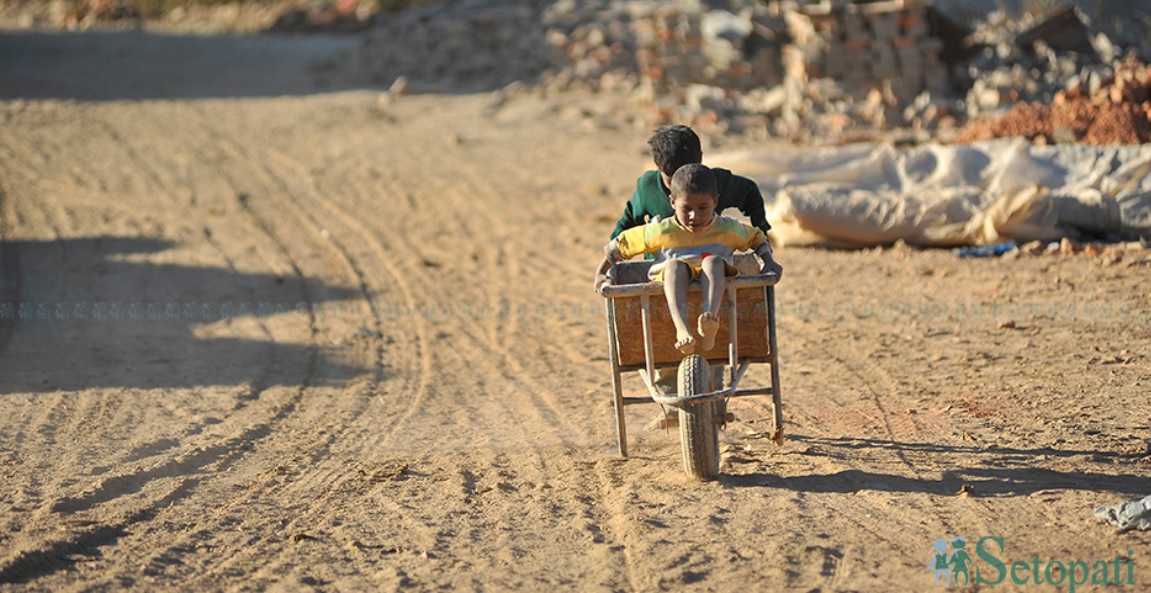A four-year-old boy is waiting at the outpatient department (OPD) of Kanti Children Hospital for his turn to visit a doctor. He frequently asks his mother, when his turn would come. It seems that he gets frustrated at waiting for hours to get his name called.
The OPD is overcrowded. The doctor just called the 14th patient and his turn is six patients later. The child was wheezing for a year along with a common cold, light fever, and sweating, according to his mother Sita Koirala, who reached the hospital after taking his ailing son from Kalanki. In the beginning, he was suspected of having pneumonia but later was diagnosed with asthma.
"Since then, he has needed regular health checkups every month," she said in an annoyed voice caressing the back of the child, "Situation becomes worse in cold and smoggy atmosphere."
Doctors have suggested that the child should avoid exposure to cold, dust, and smoke, but it is impossible for people like us who live amidst a sea of dust to comply. The boy, a nursery student, frequently misses his school when problems become severe.
Parents in the Kathmandu Valley are worried about how to keep their children safe from air pollution. According to hospital director Dr Ganesh Kumar Rai, most of the patients in the emergency ward complain of respiratory problems. The ward is receiving both new and follow-up patients with respiratory problems.
"In the past ten years, the number of asthma, pneumonia, and chronic common cold patients has soared by 50 percent in the hospital," he said, "if this trend continues, the number will be doubled in the next 20 years."
Until 10 years ago, the hospital used to receive a record number of diarrhea and vomiting patients, but now the situation is reversing. Among 60 patients, 45 are with pulmonary problems, according to the hospital's pediatrician Dr Jyoti Ratna Dhakhwa.
In case of children, a noticeable number needs the use of a nebulizer. Pollution in the Valley is one of the major factors of a significant surge in the number of patients with respiratory problems, he added.
A seven-year-old boy from Budhanilkantha was admitted to bed number 1 of the hospital emergency ward after he complained of breathing complications. He has been under medication for asthma for the past two years and sometimes situation turns worse mainly in winter and during exposure to dust and smoke, according to his mother Rajina Lama.
According to the Department of Environment, presently, the air pollution level in the Valley has exceeded the particulate matter (PM) standard doubly. The department has set up the PM measuring instruments at six locations--Pulchowk, Bhaisepati, Ratnapark, Tribhuvan University, Shankha Park, and Birendra Awasiya Sainik School--to check the pollution level.
The Valley is gradually turning into an unsafe zone, especially for children, according to Dr Dhakhwa. Children are more vulnerable to infection as they have relatively weaker immune systems than adults.
According to doctors, dust pollutants in the air are more harmful than cigars. Chemicals like carbon monoxide and sulfur dioxide have a direct impact on the lungs and are one of the major causes of pulmonary nodules and infection.
Other various health problems like itching eyes, skin allergies, and feeling of heavy heart are due to air pollution. Likewise, exposure to indoor smoke like that produced from fire lit to maintain room temperature during winter is harmful to small children.
Oil massaging a newborn baby by the fireside has long been practiced in the Nepali society, but people are not aware that it has direct impact on the lungs of a baby. Various research works have proved that children are vulnerable to the effects of pollution since in mother wombs.
A fetus having exposure to pollution has high chances of premature birth, being underweight at delivery and facing other sorts of complications like diabetes, skin allergy and mental retardation, according to the World Health Organization (WHO)'s 2004 report.

